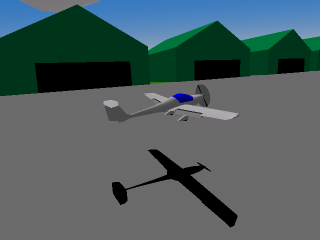| Flight Simulator
Practice - Flare (*) The contents on this page is for flying in a PC flight simulator. It is not intended for the real flight training. |
| An
airplane lands on the main landing gears with nose-high attitude.
When I was a kid, it looked mysterious to see an airplane actually
descends even when the nose points upward. Basically, you are
supposed to approach to a runway with nose-low attitude, and pull the
nose up seconds before touch down. (Although some airplane
approach with nose-high attitude like Concordes.) But, I suppose that many of flight simulator pilots feels it difficult to land on the main landing gears with nose-high attitude. So, I'd like to talk about flare (pull-up before touch down.) Actually, it's not so difficult to flare in a PC flight simulator, and you can do it after a little practice. What you need to practice first is to fly super-low altitude, like 15ft above ground. You can begin with 30ft above ground. After taking off, climb up to 300ft or so, then descend to 30ft and stay that altitude for some moment. At first, you can just neglect the airspeed, but I suggest to fly no faster than 150kt. If you are flying too fast, slight motion of the stick will easily give you 20 to 50ft climb/descend, and you may crash into the ground. After flying at 30ft above ground for several seconds, climb back up to 300ft and do the same thing over and over again until you feel it easy and never fail. This practice is somewhat boring, but fly super-low altitude is the basic of the flare, and you need to be able to do it. After you get used to it, then reduce speed to the landing speed and do the same thing. Diamond Eclipse used in the example should approach at 65 to 70kt. Because of the low speed, unless you pull up the nose enough the airplane will sink and crash into the ground. Then lower the altitude to 15ft above ground.
When you are able to do it, land with nose-high attitude is easy. Approach to the runway just like you did when you were practicing a low approach, and when you are flying super-low altitude over the runway, reduce the throttle to idle. The speed will decrease and the airplane will sink automatically and land on the main landing gear. After reducing the throttle, you should try to keep the airplane afloat as long as possible. However, if you do this in a large airliner, you may end up with hitting the tail on the ground before the main landing gear reaches the ground. So, when you are flying an airliner, you also should be careful not to pull up the nose too much. Well, doing it on the runway maybe a bit difficult first. So, I suggest you to take advantage of the flight simulation; practice over the ramp area. In YSFLIGHT, you can land on the ramp area, which is much wider than the runway. You don't have to pay attention to the lateral deviation of the approach course if you approach to the ramp area. Of course, if you do it in the real airport, you'll be arrested for the violation of Federal Aviation Regulation, unless you were in emergency. But, you don't need to worry about the regulation in the flight simulator. You can just concentrate on practicing flare. Maybe the ramp area of the Misawa airbase of AOMORI map is appropriate for this practice. You can also download the sample flight record file from the following link.
Well, I am writing this explanation as if I were a flight instructor. However, in the real world, I'm still struggling to do flare better. Of course, I can do it just sufficiently well for acquiring the private certificate. But, my landing is far from a nice smooth landing demonstrated by an instructor. I wish I could practice landing as many times as I want. But, I can do up to 10 landings in one practice even if I spend whole two hours for touch and goes. In a flight simulator, you can practice landings as many times as you want until you are really good at landing. 2006/06/13
|
|
Comments are welcome. Send E-Mail to:
|
 <= Fly
low altitude like this.
<= Fly
low altitude like this.